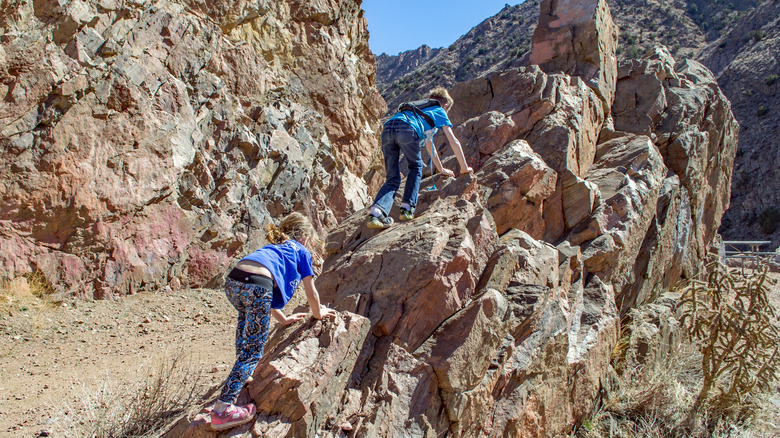Hiking, Scrambling, And Bouldering: Why It's Crucial To Understand Their Differences
In the world of outdoor adventures, hiking, scrambling, and bouldering each offer unique experiences and challenges. While they may seem similar to the uninitiated, understanding the differences between these three distinct activities is crucial for both safety and adventurous enjoyment. Most people have never heard of scrambling, while some confuse bouldering with rock climbing or even consider it to be an activity reserved solely for climbing gyms (or have the misconception that indoor bouldering equates to outdoor bouldering!).
Hiking is perhaps the most accessible, popular, and widely enjoyed of the three activities. It involves walking on established trails, from gentle, well-marked paths to challenging routes with significant elevation gain and even bushwacking. For hiking, you need minimal equipment: Most importantly, sturdy footwear that is suitable for hiking (check out our guide to the best hiking boots and shoes), appropriate clothing for the environment, and basic navigation tools like maps or GPS. Some hikers like to use walking poles to take some strain off the knees. Ultimately, all you need is your own two feet. Hiking is generally a low-risk activity, with hazards mainly related to weather conditions and trail obstacles — which vary depending on your chosen location. Different countries have different trail grading systems, but they generally range from easy to challenging. Hiking in the Patagonia region, for example, is more dangerous than hiking in Lake Tahoe's Emerald Point trail, which is perfect for beginners. The main difference between hiking and scrambling is that the latter involves having your hands in the mix.
Scrambling: the adventurous middle ground
Scrambling is the middle ground between hiking and climbing. It involves ascending rocky terrain that is steeper and more challenging than typical hiking trails, yet it doesn't usually require technical climbing equipment like ropes or harnesses. To scramble, you need robust hiking shoes with good grip, gloves for hand protection, and occasionally a helmet for safety. Scramblers use their hands for balance and support, navigating through more rugged and vertical environments in a kind of crawling-walking fashion (so greater comfort with heights is also essential). It's ideal for those looking to challenge themselves beyond hiking without committing to the full demands of rock climbing.
Scrambling is divided into grades that vary from region to region and generally range from one to four, denoting the levels of difficulty and exposure in ascending different types of terrain. Grade one is the easiest, involving simple paths with occasional hand use for balance and minimal risk, making it suitable for confident hikers. Grade two presents more complex routes that require frequent hand use and basic climbing skills. Grade three is significantly harder, demanding continuous hand use, technical climbing skills, and often the use of ropes due to considerable exposure and the potential for falls. Grade four is the most challenging, involving sustained climbing on highly exposed terrain, necessitating advanced climbing techniques and protective gear. As a result, scrambling requires more careful route planning and selection than hiking, and a keen awareness of one's physical abilities. If you plan to undertake a scrambling expedition, study the terrain beforehand.
Bouldering: the art of short, intense climbing
For the last and most intense activity of the three: bouldering. This is a form of rock climbing performed on small rock formations or artificial rock walls, without the use of ropes or harnesses. It focuses on short but intense climbing routes known as "problems," which require a combination of strength, technique, and puzzle-solving skills. It differs from standard rock climbing or free solo climbing because bouldering focuses on short rock faces and boulders fewer than 20 feet in height, with an emphasis on horizontal versus vertical climbs. In contrast, rock climbing involves taller ascents with ropes and harnesses for protection, while free solo is the same but without any protective equipment. Think of bouldering as short-lasting, super-intense scrambling merged with rock climbing.
Bouldering requires some specialized equipment: climbing shoes, chalk for grip, and crash pads. There is a higher risk of falls compared to scrambling and hiking, but crash pads and spotters (fellow boulders) help mitigate that. It is a social and accessible sport, often practiced in groups where climbers can share techniques and support each other. Despite its shorter routes, the physical and mental challenges of bouldering make it a rewarding activity for those willing to push their limits. In Italy, there is even an urban bouldering competition where people climb walls and buildings that line the city streets! Hopefully, by understanding the differences between hiking, scrambling, and bouldering, outdoor enthusiasts can make informed choices to ensure safety, fun, and exploration.


